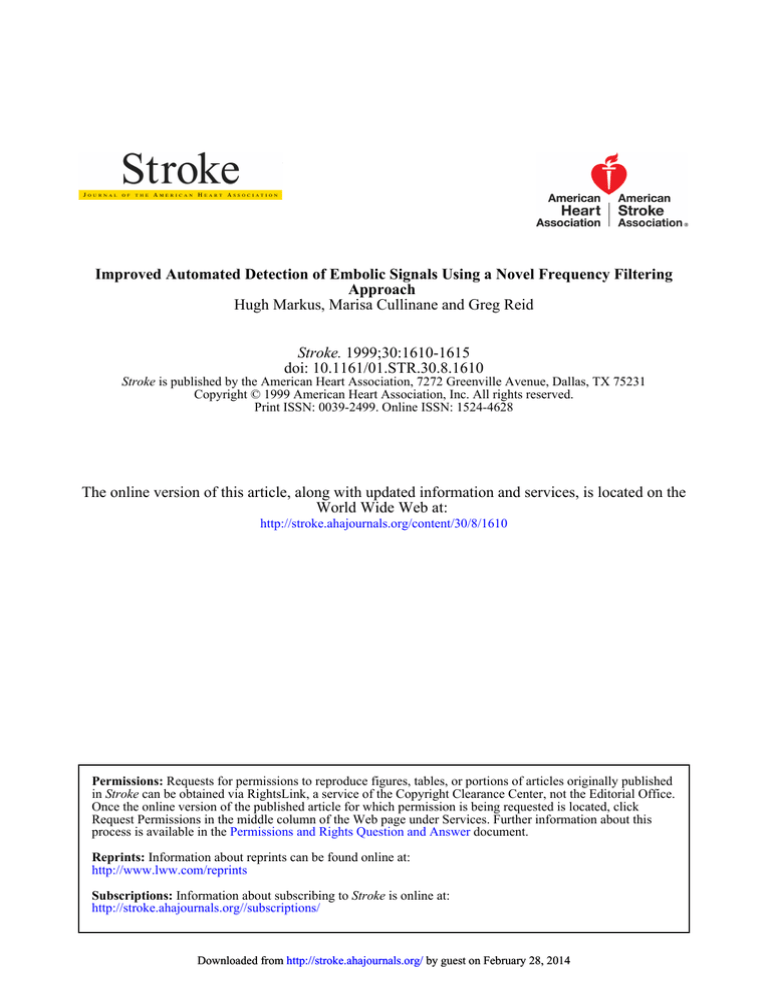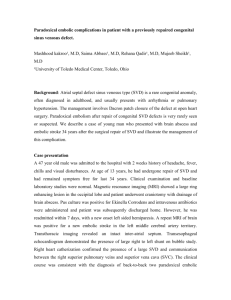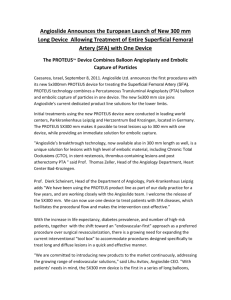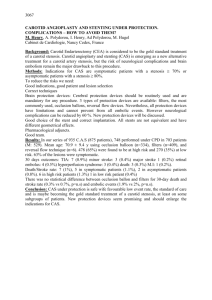
Improved Automated Detection of Embolic Signals Using a Novel Frequency Filtering
Approach
Hugh Markus, Marisa Cullinane and Greg Reid
Stroke. 1999;30:1610-1615
doi: 10.1161/01.STR.30.8.1610
Stroke is published by the American Heart Association, 7272 Greenville Avenue, Dallas, TX 75231
Copyright © 1999 American Heart Association, Inc. All rights reserved.
Print ISSN: 0039-2499. Online ISSN: 1524-4628
The online version of this article, along with updated information and services, is located on the
World Wide Web at:
http://stroke.ahajournals.org/content/30/8/1610
Permissions: Requests for permissions to reproduce figures, tables, or portions of articles originally published
in Stroke can be obtained via RightsLink, a service of the Copyright Clearance Center, not the Editorial Office.
Once the online version of the published article for which permission is being requested is located, click
Request Permissions in the middle column of the Web page under Services. Further information about this
process is available in the Permissions and Rights Question and Answer document.
Reprints: Information about reprints can be found online at:
http://www.lww.com/reprints
Subscriptions: Information about subscribing to Stroke is online at:
http://stroke.ahajournals.org//subscriptions/
Downloaded from http://stroke.ahajournals.org/ by guest on February 28, 2014
Improved Automated Detection of Embolic Signals Using a
Novel Frequency Filtering Approach
Hugh Markus, DM; Marisa Cullinane, BSc; Greg Reid, BSEE
Background and Purpose—Asymptomatic embolic signal detection with the use of Doppler ultrasound has a number of
potential clinical applications. However, its more widespread clinical use is severely limited by the lack of a reliable
automated detection system. Design of such a system depends on accurate characterization of the unique features of
embolic signals, which allow their differentiation from artifact and background Doppler speckle. We used a processing
system with high temporal resolution to describe these features. We then used this information to design a new
automated detection system.
Methods—We used a signal processing approach based on multiple overlapping band-pass filters to characterize 100
consecutive embolic signals from patients with carotid artery disease as well as both episodes of artifact resulting from
probe tapping and facial movement and episodes of Doppler speckle. We then designed an automated detection system
based both on these embolic signal characteristics and on the fact that embolic signals have maximum intensity over a
narrow frequency range. This system was tested in real time on stored 5-second segments of data.
Results—The value of peak velocity at maximal intensity discriminated best between embolic signals and artifact and
allowed differentiation with 100% sensitivity and specificity. Relative intensity increase, intensity volume, area under
volume, average rise rate, and average fall rate appeared to discriminate best between embolic signals and Doppler
speckle. For the majority of embolic signals, the intensity increase was spread over a narrow frequency or velocity range.
The automated system we developed detected 296 of 325 carotid stenosis embolic signals from a new data set
(sensitivity, 91.1%). All 200 episodes of artifact from a new data set were differentiated from embolic signals. Only 2
of 100 episodes of speckle were misidentified as embolic signals.
Conclusions—Using a novel system for automated detection, which utilizes the fact that embolic signals have maximum
intensity over a narrow frequency range, we have achieved detection with a high sensitivity and high specificity. These
results are considerably better than those previously reported. We tested this initial system on short 5-second segments
of data played in real time. This approach now needs to be developed for use in a true online system to determine
whether it has sufficient sensitivity and specificity for clinical use. (Stroke. 1999;30:1610-1615.)
Key Words: carotid artery diseases n cerebral embolism n signal processing, computer-assisted n ultrasonography
A
symptomatic cerebral emboli can be detected with the
use of Doppler ultrasound.1 Such asymptomatic embolic
signals have been reported in patients with a wide variety of
potential embolic sources including carotid artery stenosis,
cardioembolic sources such as atrial fibrillation, and during
interventional procedures including carotid endarterectomy
and cardiopulmonary bypass.2 The technique has a number of
important potential clinical applications, including identifying individuals at high risk of stroke, monitoring the effectiveness of therapy, localizing the source of active embolization in patients with more than 1 potential embolic source,
and monitoring during interventional procedures. A major
current limitation of the technique is the lack of sufficiently
specific and sensitive techniques for automated embolic
signal detection. In many conditions the frequency of embolic
signals is low, often on the order of 1 or 2 per hour, and
therefore recordings of at least 1 hour may need to be
performed. The current gold standard for data analysis is to
record the Doppler signal and analyze it at a later date,
blinded to patient identity and diagnosis. This is timeconsuming and not clinically applicable.
Interobserver reproducibility studies have demonstrated a
high level of agreement in the identification of embolic
signals.3 However, previous systems for automated detected
have failed to achieve levels of performance approaching that
of the human observer. When analyzed with the use of the
Received April 5, 1999; final revision received May 10, 1999; accepted May 10, 1999.
From the Department of Clinical Neurosciences, Guy’s King’s and St Thomas’ School of Medicine and the Institute of Psychiatry, London, England
(H.M., M.C.), and Nicolet-EME GmbH (G.R.), Germany.
Dr Hugh Markus received support from EME-Nicolet Limited, which covered the travel and registration costs to allow presentation of the data at the
World Congress on Embolism, New Orleans, La, November 13, 1998.
Correspondence to Dr Hugh Markus, Department of Clinical Neurosciences, Institute of Psychiatry, De Crespigny Park, Denmark Hill, London SE5
8AF, England. E-mail h.markus@iop.kcl.ac.uk
© 1999 American Heart Association, Inc.
Stroke is available at http://www.strokeaha.org
1610
Downloaded from http://stroke.ahajournals.org/
by guest on February 28, 2014
Markus et al
fast Fourier transform (FFT), embolic signals have a characteristic appearance with a short-duration increase in signal
intensity, usually contained within the flow spectrum. The
intensity increase is usually frequency focused, ie, the maximum increase is at a specific frequency. Such signals have to
be differentiated from artifact, which is usually bidirectional
and has an intensity increase that is maximal at low frequency.4 They also have to be differentiated from random Doppler
speckle, and in practice this is a more difficult problem. Early
attempts at automated detection used a simple pattern recognition algorithm based on the FFT spectral analysis to detect
a transient intensity increase, but intensity measurements
were averaged over all frequencies or velocities and did not
utilize the frequency focusing of embolic signal intensity
increase in their detection.4 While such systems performed
well offline for the relatively intense embolic signals produced in experimental systems and seen in patients with
prosthetic cardiac valves,4 their performance online in the
detection of the lower-intensity embolic signals found in
patients with carotid stenosis was unsatisfactory.5 The use of
a neural network whose input is the FFT spectral analysis
achieved improved specificity but still inadequate sensitivity.6 Improved automated detection requires both (1) a signal
processing approach that will maximize the relative intensity
or embolus-to-blood ratio (EBR) for individual signals and
(2) an algorithm programmed to detect those features characteristic of embolic signals that allow differentiation from
artifact signals and Doppler speckle. Regarding the first
point, it is likely that the EBR can be increased by the use of
a frequency filtering approach; the relative intensity increase
of the embolic signal compared with that of the background
will be greater if analysis is restricted to only those frequencies at which the embolic signal occurs. We have previously
shown that utilizing this frequency information and applying
a band-pass frequency filter to the embolic signal resulted in
a 3-dB intensity increase.7 In this previous study, the frequency range of the filter was chosen offline to suit the
particular embolic signal. In practice, the frequency at which
the maximal intensity increase will occur cannot be known in
advance. Therefore, analysis must be performed concurrently
over a number of frequency or velocity bands that cover the
range over which an embolic signal may occur. Regarding the
second point, before an effective system for automated signal
detection is designed, the characteristics of embolic signals
must be fully described. A number of features of embolic
signals have not been previously studied and may be useful in
their detection.
In this study we used a novel form of signal processing
based on a number of parallel frequency filters to analyze
embolic signals with a high degree of temporal resolution.
We determined which features most accurately differentiated
embolic signals from speckle and artifact. In the second half
of the study, we used this information to design a computer
algorithm for embolic signal detection that also utilized the
frequency focusing of the embolic signal intensity increase.
Subjects and Methods
Transcranial Doppler Recordings
Transcranial Doppler recordings were performed with the use of a
commercially available transcranial Doppler system (Pioneer 4040,
Automated Detection of Embolic Signals
1611
Nicolet-EME GmbH). This system is based on a 75-MHz processor.
Recordings were made from the ipsilateral middle cerebral artery in
patients with symptomatic carotid stenosis. The Doppler signals
were recorded onto digital audiotape and subsequently played back
through the same machine, at which time a 128-point FFT was
performed. Segments containing embolic signals were saved with the
use of proprietary SoundTrak software; this software allows the
audio time domain data to be saved to the disk along with the spectral
FFT information for each spectral record. Successive embolic signals
were identified subjectively by recognized criteria, including both
the audible and visible characteristics on the spectral display, and
were saved to the disk. Embolic signals were identified as shortduration, high-intensity, frequency-focused signals accompanied by
a characteristic audible click.8 In addition, an intensity threshold of
7 dB was used because this has been found to improve specificity
without an excessive loss of sensitivity.9 All embolic signals were
reviewed by a second experienced observer, and only those that both
observers agreed were definite embolic signals were used in further
analysis. One hundred successive embolic signals recorded from 3
individuals with carotid stenosis were used for the initial study. Two
hundred episodes of artifact produced by probe tapping (n5100) or
facial movement (n5100) were also studied. A second independent
data set of 325 embolic signals recorded from an additional 8 patients
with symptomatic carotid stenosis was used for evaluation of the
software; these were identified by the same criteria by the same
observers.
Doppler Signal Analysis Using Frequency Filters
An array of band-pass filters was applied to the time domain data.
Band-pass filters are defined by their ability to discriminate in favor
of or against particular frequency bands.7 The frequencies to be
filtered were selected by sizing a box around the section of the signal
to be analyzed, ie, an embolic signal, artifact, or random Doppler
speckle, as identified on the FFT spectra. The frequencies selected
from the box were divided into 256 subbands, each of equal
frequency range. For each subband, a separate set of finite impulse
response band-pass filter coefficients was calculated. The filter
coefficients were then applied to the time domain data selected, with
application of a Hanning windowing function centered at each time
value. This resulted in a sequence of filtered time domain data values
representing the time domain signal within each of the 256 frequency
subbands. Each of these time domain data values consisted of an
in-phase and quadrature value. These were converted to signal
intensity in decibels. The filtered time domain intensity values for
each individual frequency filter output were displayed as a single
horizontal row, representing one subband of time domain data. The
software was programmed to determine specific characteristics for
individual embolic signals. Relative intensity increase was determined from peak intensity minus background intensity. Intensity
volume was determined from intensity summed over the area of the
event. The time of onset of the intensity of increase and the time at
peak intensity were determined, and from these values the average
intensity rise rate was determined. Similarly, the average intensity
fall rate was determined. The peak velocity at peak intensity was
determined. Peak sample length was derived from peak velocity
multiplied by the time width of the embolus. The degree of
frequency focusing of the embolic signals was determined from the
ratio of the frequency range of the embolic signal at its time point of
maximum intensity to the frequency range of the flow velocity
envelope curve at that time.
The portion of the embolic signal that was analyzed for these
calculations was determined by the region over which intensity was
above a running background threshold intensity. This was calculated
over the previous 1.5 seconds of data. All samples of negative flow
or those within 1/8 of the pulse repetition frequency were excluded.
The highest 1/32 of samples were then excluded, and the next 1/32
of samples were averaged and converted to decibels to determine the
background threshold. An example is shown in the Figure.
Downloaded from http://stroke.ahajournals.org/ by guest on February 28, 2014
1612
Stroke
August 1999
An embolic signal analyzed with the band-pass filter approach in part 1 of the study. The upper tracing shows a normal Doppler spectrum. The filter box has been manually placed around the embolic signal. The lower tracing shows the output from the frequency filter
analysis. The embolic signal is shown with both high-frequency and temporal resolution. The point of maximum intensity is shown by a
cross. Contours are drawn around the embolic signal at the intensity threshold, as described in the text. A number of embolic signal
characteristics are then generated, as described in the text.
Automated Embolic Signal Algorithm
Because of the processing constraints of an online band-pass filtering
system, analysis was based on a 64-point FFT, with each point of the
FFT used as a “frequency filter.” The data from each individual
frequency bin of the FFT were analyzed to determine the presence or
absence of any potential embolic signal. FFTs were performed every
1 ms with the use of a Hanning windowing function. For each FFT
there were 32 bins of positive frequencies and 32 bins of negative
frequencies. For each FFT computed, 64 independent thresholds
were set by averaging the data for each bin over 610 cm/s in the
frequency or velocity domain and 650 ms in the time domain.
Extremely sharp transitions were ignored, and specific minimum and
maximum values were used to ensure reasonable thresholds. This
resulted in a “bed” of thresholds that “floats” slightly above the
median intensity level of physiological blood flow. Any part of the
signal that rose above this threshold was considered an event
candidate, and this was then analyzed further to determine whether it
was likely to be an embolic signal, an artifact, or speckle. The
information from the first part of the study was applied for this
analysis. Artifact probabilities were summed from the measures of
the degree to which the intensity increase was symmetrical and
bidirectional, and the degree to which the intensity increase was
adjacent and maximal next to the zero line was used to design an
algorithm. Emboli probabilities were summed from measurements of
the following: (1) intensity volume, ie, the intensity of the signal
above the threshold intensity integrated over the time and frequency
range of the event; (2) intensity area, ie, the frequency range of the
signal integrated over its time duration; (3) duration of the event in time;
and (4) orderliness of the signal over time. This utilized the finding that
a gradual rise and then fall in intensity were found for embolic signals,
in contrast to a fluctuating rise and fall in intensity for speckle.
After independent embolic signal and artifact probabilities had
been computed, an embolic signal probability score and an artifact
signal probability score were generated. If the probability score of
the embolic signal was .60%, the event was labeled as an embolic
signal, unless the artifact score was also .60%.
Results
Embolic Signal Characteristics
Differentiation of Embolic Signals From Artifact
The value of peak velocity at maximal intensity discriminated
best between embolic signals and artifact. Velocity at peak
intensity was significantly higher for embolic signals (mean,
33.67; SD, 17.45; range, 9.16 to 71.63 cm/s) than for either
tapping artifact (mean, 1.94; SD, 2.64; range, –3.95 to 5.27
cm/s; P,0.0001) or facial movement artifact (mean, 0.01;
SD, 2.41; range, –5.74 to 6.34 cm/s; P,0.0001). Using a
Downloaded from http://stroke.ahajournals.org/ by guest on February 28, 2014
Markus et al
Automated Detection of Embolic Signals
1613
TABLE 1. Parameters for Embolic Signals, Normal Doppler Speckle, and Artifactual Signals Created by
Probe Tapping or Facial Movement
Artifact
Embolic Signal
(n5100)
Area under volume, cm/ms
0.25 (0.19)
Speckle
(n5100)
Probe Taps
(n5100)
0.02 (0.01)
1.67 (0.60)
Facial Movement
(n5100)
0.15 (0.11)
P
,0.0001*
,0.0001†
,0.0001‡
,0.0001§
,0.0001\
Average fall rate, dB/ms
21.47 (20.54)
20.54 (0.13)
20.80 (0.30)
20.65 (0.35)
,0.0001*
,0.0001†
,0.0001‡
,0.0001§
0.002\
Average rise rate, dB/ms
1.53 (0.38)
0.58 (0.13)
2.29 (0.64)
0.69 (0.34)
,0.0001*
,0.0001†
,0.0001‡
,0.0001§
0.003\
Intensity volume, dB/cm
1.20 (2.20)
0.03 (0.03)
33.48 (13.47)
0.83 (1.05)
,0.0001*
,0.0001†
,0.0001‡
,0.0001§
,0.0001\
Peak intensity2background intensity, dB
11.59 (5.54)
1.85 (0.87)
35.94 (4.71)
7.60 (4.99)
,0.0001*
,0.0001†
,0.0001‡
,0.0001§
,0.0001\
Peak sample length, cm
0.48 (0.18)
0.17 (0.08)
0.22 (0.07)
0.49 (0.04)
,0.0001*
,0.0001†
,0.0001‡
,0.0001§
,0.0001\
Values are mean (SD).
*Embolic signals vs normal Doppler speckle.
†Embolic signals vs probe tapping.
‡Embolic signals vs facial movement.
§Normal Doppler speckle vs probe tapping.
\Normal Doppler speckle vs facial movement.
threshold of .7 cm/s achieved 100% specificity and sensitivity in detecting embolic signals and differentiating them
from artifact.
Differentiation of Embolic Signals From Speckle
Mean values of the various signal characteristics for embolic
signals, speckle, and artifact are shown in Table 1. Relative
intensity increase, intensity volume, and area under volume
were all significantly greater for embolic signals than for
Doppler speckle. Average rise rate was significantly faster
and average fall rate was significantly slower for embolic
signals than for Doppler speckle.
The important issue is how well individual parameters
discriminate embolic signals from both Doppler speckle and
artifact. Relative intensity increase, intensity volume, area
under volume, average rise rate, and average fall rate appeared to discriminate best between embolic signals and
Doppler speckle. The sensitivity of each parameter for detecting embolic signals, at a threshold at which 100% specificity was achieved in differentiating speckle from embolic
signals, is shown in Table 2.
For the majority of embolic signals, the intensity increase
was spread over only a proportion of velocities occupied by
the flow spectrum. The mean (SD) proportion of the flow
spectrum that was taken up by the intensity increase of the
embolic signal was 0.57 (0.15) (range, 0.35 to 1.00).
Downloaded from http://stroke.ahajournals.org/ by guest on February 28, 2014
1614
Stroke
August 1999
TABLE 2. Sensitivity Achieved When Different Parameters
Were Used to Differentiate Embolic Signals From Doppler
Speckle and the Threshold Was Set at a Value to Allow
100% Specificity
Parameter
Threshold to Achieve
100% Specificity
Sensitivity for
Embolic
Signals, %
Relative intensity increase, dB
.4.60
93
Intensity volume
.0.121
95
Area under volume
.0.0603
94
Average rate rise
.1.050
94
Average fall rate
,0.915
92
Sample volume length
.0.450
80
Evaluation of Automated Detection System
In the analysis of the first data set on which the previous analysis
and software development had been performed, 96 of 100
embolic signals were detected. In the second independent data
set of 325 embolic signals, 296 were detected (91.1%). All 200
episodes of artifact from a new data set (100 probe tapping, 100
facial movement) were not detected as embolic signals. Two of
100 episodes of speckle were identified as embolic signals.
Discussion
In this study we used a signal processing approach with a high
temporal resolution to describe the characteristics of embolic
signals compared with episodes of random Doppler speckle
and artifact. We were able to develop a semiautomated
detection system that can detect the relatively low-intensity
embolic signals occurring in individuals with carotid artery
stenosis with a higher sensitivity than previous systems. We
have demonstrated its effectiveness in analyzing short segments of stored data played back in real time.
In developing a sensitive and specific automated embolic
signal detection system, 2 aspects are of great importance.
First, the signal-to-noise ratio or the ratio of embolic signal to
background intensity or power (EBR) must be maximized.
This increases the conspicuity of the embolic signal and
makes it easier to detect and differentiate it from other types
of signal. A characteristic feature of an embolic signal is that
it is frequency focused, with the maximum intensity greatest
over a narrow band of frequencies or velocity. We have
confirmed this in our analysis. Consequently, if the intensity
increase is calculated over a narrow frequency band, which is
centered on the frequency at which the embolic signal has
maximum intensity, the EBR will be increased. We have
demonstrated this in a previous study and shown that a mean
3-dB increase in EBR can be achieved by a frequency
filtering approach. In this previous study the frequency range
of the filter was chosen offline to suit the particular embolic
signal.7 In practice, the frequency or velocity at which the
maximal intensity increase will occur cannot be known in
advance. Therefore, analysis must be performed concurrently
over a number of frequency or velocity bands that cover the
range over which an embolic signal may occur. Initially we
performed this frequency analysis using a band-pass filter
approach, which has the advantage of a very high temporal
resolution. However, this requires considerable computing
power, making it more difficult to apply online. Therefore, we
adapted the approach to use an FFT processing approach. The
FFT analyzes the signal at a number of different frequencies or
frequency bins, and the output of each bin can be considered
equivalent to that of a band-pass filter. By concurrently monitoring signal changes over time in the output from each FFT
frequency bin, we have been able to improve the sensitivity and
specificity by which we can detect embolic signals. It is possible
to run such a processing approach on currently available transcranial Doppler equipment.
In addition to optimizing the signal-to-noise ratio, detection of
embolic signals requires an algorithm that can differentiate
embolic signals from speckle and artifact. We have demonstrated the characteristics of embolic signals that may be most
useful in developing such an algorithm. Intensity volume differentiates embolic signals from speckle better than relative intensity alone, and therefore we used this parameter in our algorithm.
The rate of rise of the intensity increase of an embolic signal, as
well as the rate of fall, also allowed differentiation of embolic
signals from speckle. In contrast, these parameters are poor in
differentiating embolic signals from artifact, but this can be
performed by analysis of the velocity at peak signal intensity.
Artifacts have an intensity that is maximal at low velocity, and
using a threshold of 9 cm/s, we differentiated between embolic
signals and artifact with 100% sensitivity and specificity.
This semiautomated detection system allows considerable
improvement in automated embolic signal detection. Using
previous much simpler algorithms in which the intensity
increase was measured over the total frequency range, we and
others were able to only obtain sensitivities of approximately
60% for similar embolic signals.5 The embolic signals from
patients with carotid artery stenosis and atrial fibrillation tend
to be less intense and are therefore more difficult to detect than
the more intense embolic signals in patients with prosthetic heart
valves or undergoing cardiopulmonary bypass.10 This emphasizes the importance of developing and testing detection devices
for the data set on which they will be used.
We evaluated this system using consecutive embolic signals from patients with carotid artery stenosis. We only
studied embolic signals with an intensity of .7 dB. This is
the standard threshold we use in studies, and embolic signals
defined in this way correlate with clinical parameters of
increased risk and also with prospective risk of stroke and
transient ischemic attack.11 The present study demonstrates
the feasibility of detecting such embolic signals automatically. We have not tested it on very-low-intensity embolic
signals, on which its performance may not be as good.
However, interobserver agreement for such signals is less
good,3 and the lack of a reliable gold standard for such signals
makes evaluation of an automated detection system difficult
for such signals. Furthermore, it should be remembered that
our gold standard was the subjective identification of embolic
signals by 2 experienced observers; this is not ideal, but there
is no readily available alternative. While good interobserver
agreement has been demonstrated, particularly for signals of
.7 dB relative intensity, once a fully automated online
system is developed, it should be tested against a number of
independent expert observers.
Downloaded from http://stroke.ahajournals.org/ by guest on February 28, 2014
Markus et al
Our results demonstrate that by utilizing specific characteristics of embolic signals that allow differentiation from
other transient signals and using a novel detection algorithm
running concurrently across a number of frequency or velocity bands, considerable improvement in the sensitivity and
specificity of embolic signal detection can be achieved. We
tested this initial system on short 5-second segments of data
played in real time. This approach now needs to be developed
for use in a true online system to determine whether it has
sufficient sensitivity and specificity for clinical use. It is
likely that under conditions in which embolic signals are
frequent, such as after carotid endarterectomy, this system
will be clinically useful. It remains to be determined whether
its specificity is sufficiently good for use in situations in
which embolic signals are much less frequent.
Acknowledgment
This study was supported by a grant from the British Heart
Foundation (PG 96176).
References
1. Spencer MP, Thomas GI, Nicholls SC, Sauvage LR. Detection of middle
cerebral artery emboli during carotid endarterectomy using transcranial
Doppler ultrasonography. Stroke. 1990;21:415– 423.
Automated Detection of Embolic Signals
1615
2. Markus H. Transcranial Doppler detection of circulating cerebral emboli:
a review. Stroke. 1993;24:1246 –1250.
3. Markus HS, Ackerstaff RG, Babikian VL, Bladin C, Droste D, Grosset D,
Levi C, Russell D, Siebler M, Tegeler C. Intercenter agreement in reading
Doppler embolic signals: a multicenter international study. Stroke. 1997;
28:1307–1310.
4. Markus H, Loh A, Brown MM. Computerized detection of cerebral
emboli and discrimination from artifact using Doppler ultrasound. Stroke.
1993;24:1667–1672.
5. Van Zuilen EV, Mess WH, Jansen C, Van der Tweel I, van Gijn J,
Ackerstaff RGA. Automatic embolus detection compared with human
experts: a Doppler ultrasound study. Stroke. 1996;27:1840 –1843.
6. Siebler M, Rose G, Sitzer M, Bender A, Steinmetz H. Real-time identification of cerebral microemboli with US feature detection by a neural
network. Radiology. 1994;192:739 –742.
7. Markus HS, Reid G. Frequency filtering improves ultrasonic embolic
signal detection. Ultrasound Med Biol. In press.
8. Ringlestein EB, Droste DW, Babikian VL, Evans DH, Grosset DG, Kaps
M, Markus HS, Russell D, Siebler M, for the International Consensus
Group on Microembolus Detection. Consensus on microembolus
detection by TCD. Stroke. 1998;29:725–729.
9. Markus HS, Molloy J. The use of a decibel threshold in the detection of
embolic signals. Stroke. 1997;28:692– 695.
10. Grosset DG, Georgiadis D, Kelman AW, Lees KR. Quantification of
ultrasound emboli signals in patients with cardiac and carotid disease.
Stroke. 1993;24:1922–1924.
11. Molloy J, Markus HS. Asymptomatic embolization predicts stroke and
TIA risk in patients with carotid artery stenosis. Stroke. 1999;30:
1440 –1443.
Downloaded from http://stroke.ahajournals.org/ by guest on February 28, 2014






